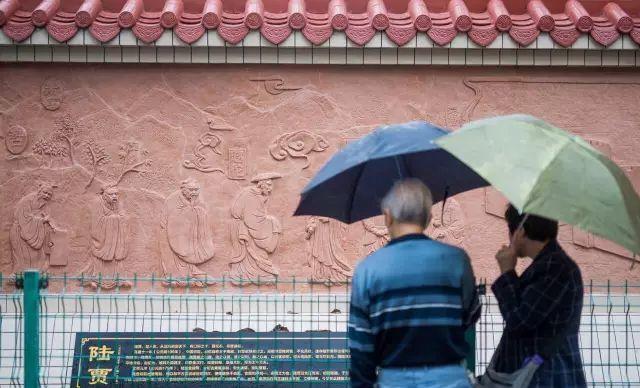Under the sun, ancient buildings reflect unique light and shadow. It is a corner of the noisy street market, and it is using its unique silence to turn a new page of the times and tell a good story from a thousand years ago.

The hero is everywhere happy, and the old man is still more than enough to dress.
Weedo is naturally over-irrigated, and it seems to be peaceful.
—— "Hanging Lu Jia Cheng" Qing Li Weiwei
In the view of the Qing Dynasty poet Li Weiwei, Lu Jia, who was first-class in oral eloquence, was as talented as the four famous ministers of the early Han Dynasty. Lu Jia is well known as a Han Dynasty political diplomat who persuaded the South Vietnamese state to surrender and ensure the peace of the southern Yue side.
When Liu Bang, the ancestor of Han Gao, unified the Central Plains, the southern Guangdong region was still not annexed to the Han Dynasty. In 196 BC, Liu Bang sent Lu Jia as an emissary to persuade him to surrender. Lu Jia was ordered to lead the team to South Vietnam on an official ship and landed at the ancient Village of Aokou, the Xiguan Wharf in ancient Guangzhou. At that time, Zhao Tuo refused to receive Lu Jia by virtue of the relatively strong state of South Vietnam, and Lu Jia built a ten-mile city pool on the shore and lived for several months. Under the efforts of Lu Jia, Zhao Tuo was finally moved, submitted to the Han Dynasty, and was given the title of King of Nanyue by Han Gaozu, and Lu Jia was also given the title of Taizhong Dafu.
The power plant contains a thousand-year-old stone stele
The story of persuasion from a thousand years ago has long been annihilated in the long river of history, so is it still the mark of history? According to the examination of Lu's descendants, the "Aokou Ancient Village" is in today's Guangzhou Power Plant, and the ancient wharf where Lu Jia landed should be located near the monument of the power plant. "When I was a kid, we could still see Mud City. At that time, the main mode of transportation was waterways, and boating could be seen everywhere. It is surrounded by hills and several shops grinding rice on both sides of the pier. Cai Chengxuan, an old neighbor of Aokou Village, was deeply impressed by the mud city that accompanied them to grow up. According to Cai Chengxuan, there was also a "mud city" on the map of the Qing Dynasty, until the 50s and 60s of the last century, when the Guangzhou power plant included the "mud city" into the scope of the power plant, so that the "mud city" gradually disappeared from everyone's sight.
"There was originally a Lu Jia memorial pavilion in the power plant, but later the pavilion was demolished, leaving only 3 stele stones inside, and the middle stele was engraved with the inscription 'Kaiyue Lu Dafu's former site of residence'." In Cai Chengxuan's view, "Kaiyue" has the meaning of opening up, enlightenment and communication, which also expresses the respect of the people of Guangzhou to commemorate Lu Jia, the great messenger of peace in Chinese history. But unfortunately, a stone stele nearly 2 meters high was used as a brick into the wall. The power plant that cannot be entered and exited at will has also hindered the public's free viewing of the Lujia Stone Monument, and the Mud City, Lujiating and Lujia Monument have long become places for "one question and three unknowns".
Lu Jia Culture walked out of the power plant
The wheel of history is rolling forward, and the passage of time has also made people feel more and more unfamiliar with Lu Jia, the messenger of peace. Cai Chengxuan introduced to nan friends that he had watched the wax statue exhibition of "Nanyue Sages" held by the Five Immortals Temple in Yuexiu District, but found that there was no Lu Jia who had a profound influence on Southern Yue. The reason for this is that it is widely believed that Lu Jia did not serve as an official in Southern Yue, but only stayed here. Cai Chengxuan did not think so, believing that Lu Jia had a profound influence on Southern Yue, which must not be ignored.
In 2002
The stele of "South Vietnam Lu Dafu's Former Site of the Festival" was rated as a cultural relics protection unit in Guangzhou. Lujia culture is certified.
In 2015
Nanyuan Street has completed the construction of the statue of Dr. Lu, the monument to Dr. Lu, and the monument to the replica of the "Kaiyue Lu Dafu's Former Site". "Today's statue of Lu Dafu was placed in the electricity community, and this 'one statue and two monuments' allows the neighbors to better understand the Lujia culture, and also breaks the 'wall' that the power plant was blocked by the power plant in the past." The staff of the Nanyuan Street Cultural Station explained.
In 2016
Nanyuan Street is keenly innovated, "telling" the story of Dr. Lu in the form of a relief wall.
Nowadays, every time you pass by the relief wall, you will always see the neighbors stop and stay to understand this ancient story.
【Graphic reporter Nan Friends】
【Edit Bugs】